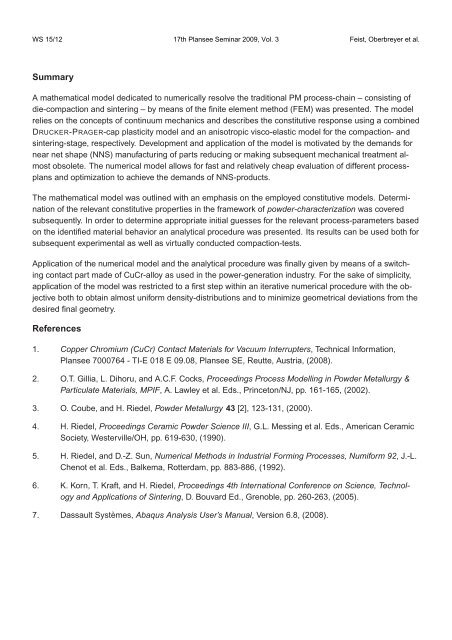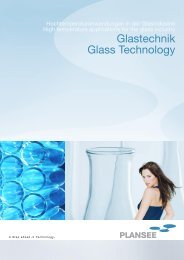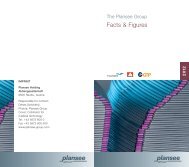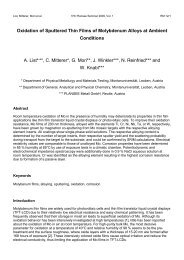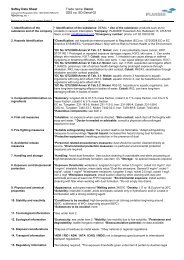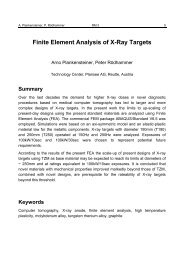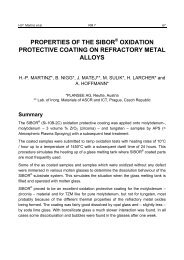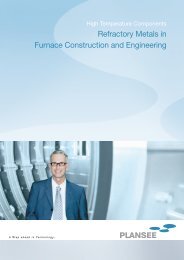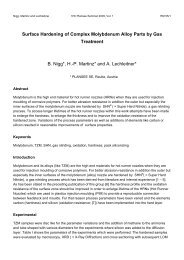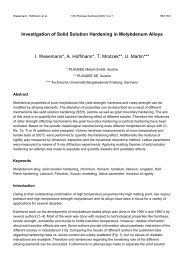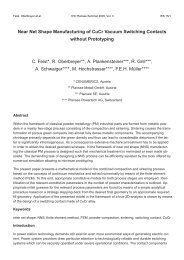Near Net Shape Manufacturing of CuCr Vacuum Switching Contacts ...
Near Net Shape Manufacturing of CuCr Vacuum Switching Contacts ...
Near Net Shape Manufacturing of CuCr Vacuum Switching Contacts ...
You also want an ePaper? Increase the reach of your titles
YUMPU automatically turns print PDFs into web optimized ePapers that Google loves.
WS 15/12 17th Plansee Seminar 2009, Vol. 3 Feist, Oberbreyer et al.<br />
Summary<br />
A mathematical model dedicated to numerically resolve the traditional PM process-chain – consisting <strong>of</strong><br />
die-compaction and sintering – by means <strong>of</strong> the finite element method (FEM) was presented. The model<br />
relies on the concepts <strong>of</strong> continuum mechanics and describes the constitutive response using a combined<br />
DRUCKER-PRAGER-cap plasticity model and an anisotropic visco-elastic model for the compaction- and<br />
sintering-stage, respectively. Development and application <strong>of</strong> the model is motivated by the demands for<br />
near net shape (NNS) manufacturing <strong>of</strong> parts reducing or making subsequent mechanical treatment almost<br />
obsolete. The numerical model allows for fast and relatively cheap evaluation <strong>of</strong> different processplans<br />
and optimization to achieve the demands <strong>of</strong> NNS-products.<br />
The mathematical model was outlined with an emphasis on the employed constitutive models. Determination<br />
<strong>of</strong> the relevant constitutive properties in the framework <strong>of</strong> powder-characterization was covered<br />
subsequently. In order to determine appropriate initial guesses for the relevant process-parameters based<br />
on the identified material behavior an analytical procedure was presented. Its results can be used both for<br />
subsequent experimental as well as virtually conducted compaction-tests.<br />
Application <strong>of</strong> the numerical model and the analytical procedure was finally given by means <strong>of</strong> a switching<br />
contact part made <strong>of</strong> <strong>CuCr</strong>-alloy as used in the power-generation industry. For the sake <strong>of</strong> simplicity,<br />
application <strong>of</strong> the model was restricted to a first step within an iterative numerical procedure with the objective<br />
both to obtain almost uniform density-distributions and to minimize geometrical deviations from the<br />
desired final geometry.<br />
References<br />
1. Copper Chromium (<strong>CuCr</strong>) Contact Materials for <strong>Vacuum</strong> Interrupters, Technical Information,<br />
Plansee 7000764 - TI-E 018 E 09.08, Plansee SE, Reutte, Austria, (2008).<br />
2. O.T. Gillia, L. Dihoru, and A.C.F. Cocks, Proceedings Process Modelling in Powder Metallurgy &<br />
Particulate Materials, MPIF, A. Lawley et al. Eds., Princeton/NJ, pp. 161-165, (2002).<br />
3. O. Coube, and H. Riedel, Powder Metallurgy 43 [2], 123-131, (2000).<br />
4. H. Riedel, Proceedings Ceramic Powder Science III, G.L. Messing et al. Eds., American Ceramic<br />
Society, Westerville/OH, pp. 619-630, (1990).<br />
5. H. Riedel, and D.-Z. Sun, Numerical Methods in Industrial Forming Processes, Numiform 92, J.-L.<br />
Chenot et al. Eds., Balkema, Rotterdam, pp. 883-886, (1992).<br />
6. K. Korn, T. Kraft, and H. Riedel, Proceedings 4th International Conference on Science, Technology<br />
and Applications <strong>of</strong> Sintering, D. Bouvard Ed., Grenoble, pp. 260-263, (2005).<br />
7. Dassault Systèmes, Abaqus Analysis User’s Manual, Version 6.8, (2008).


